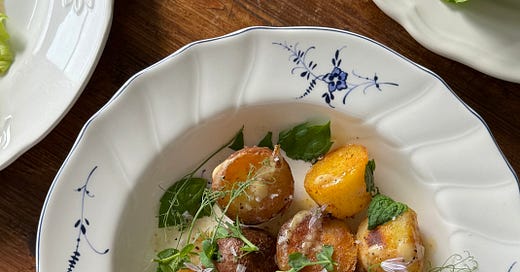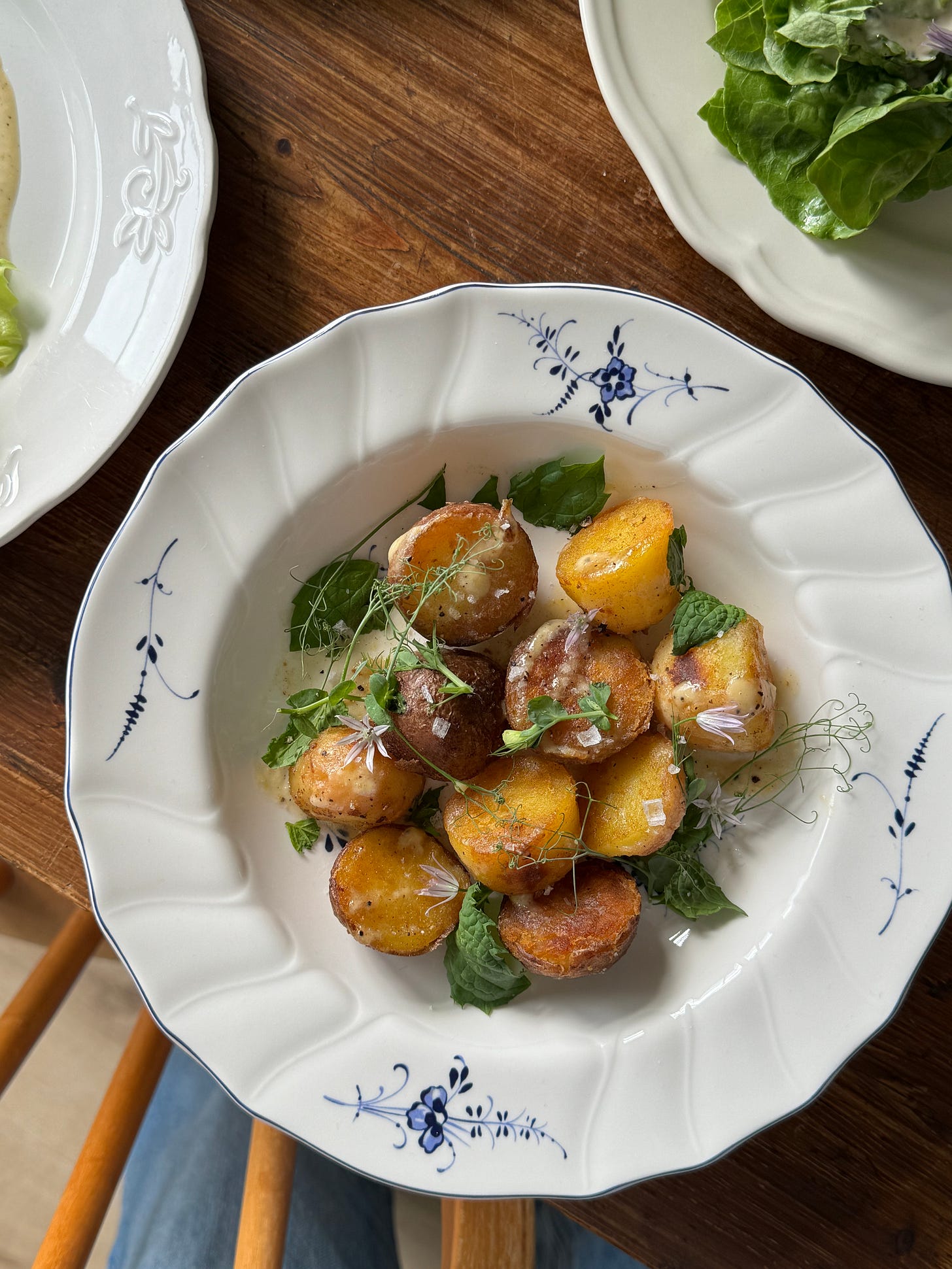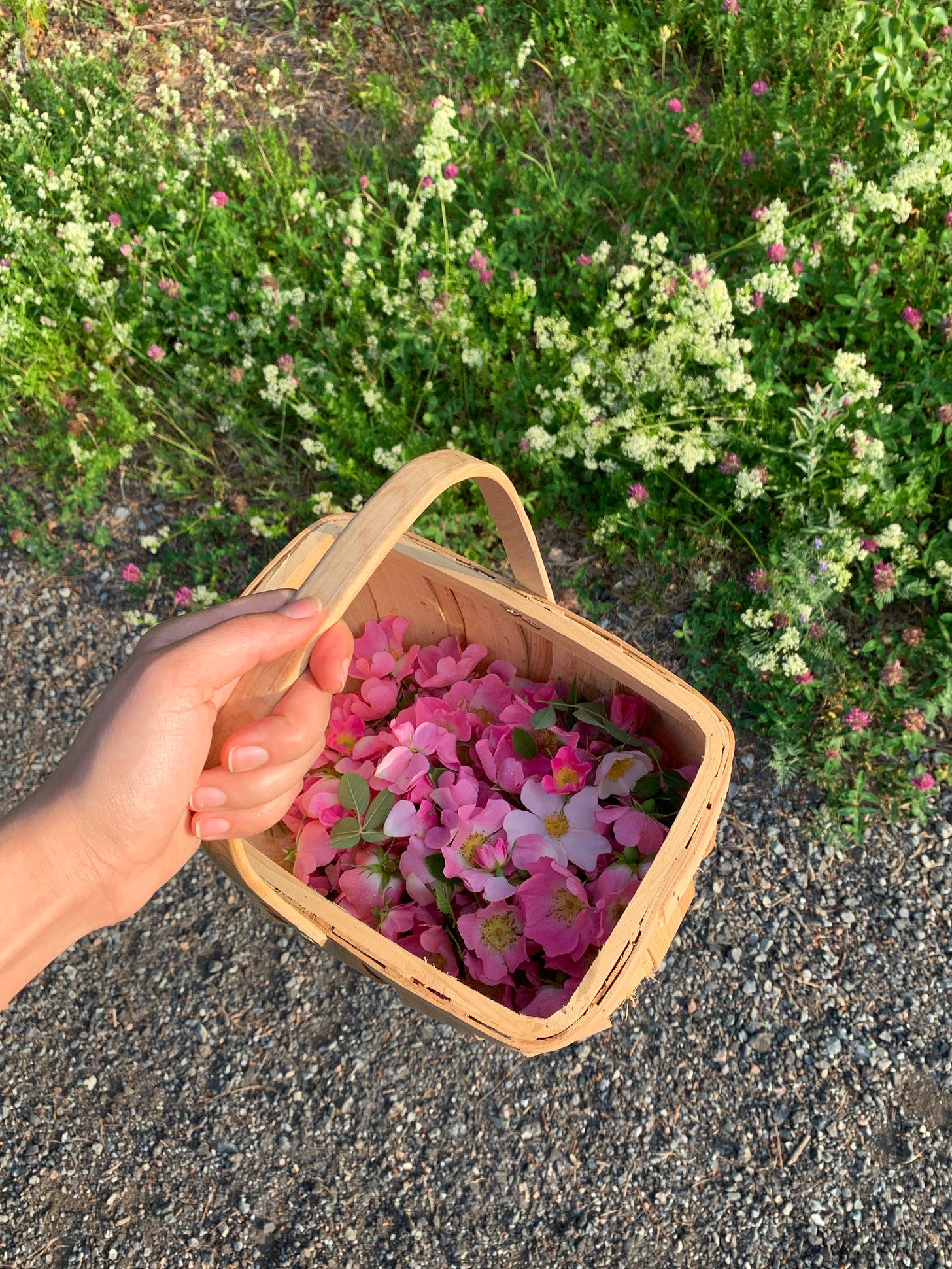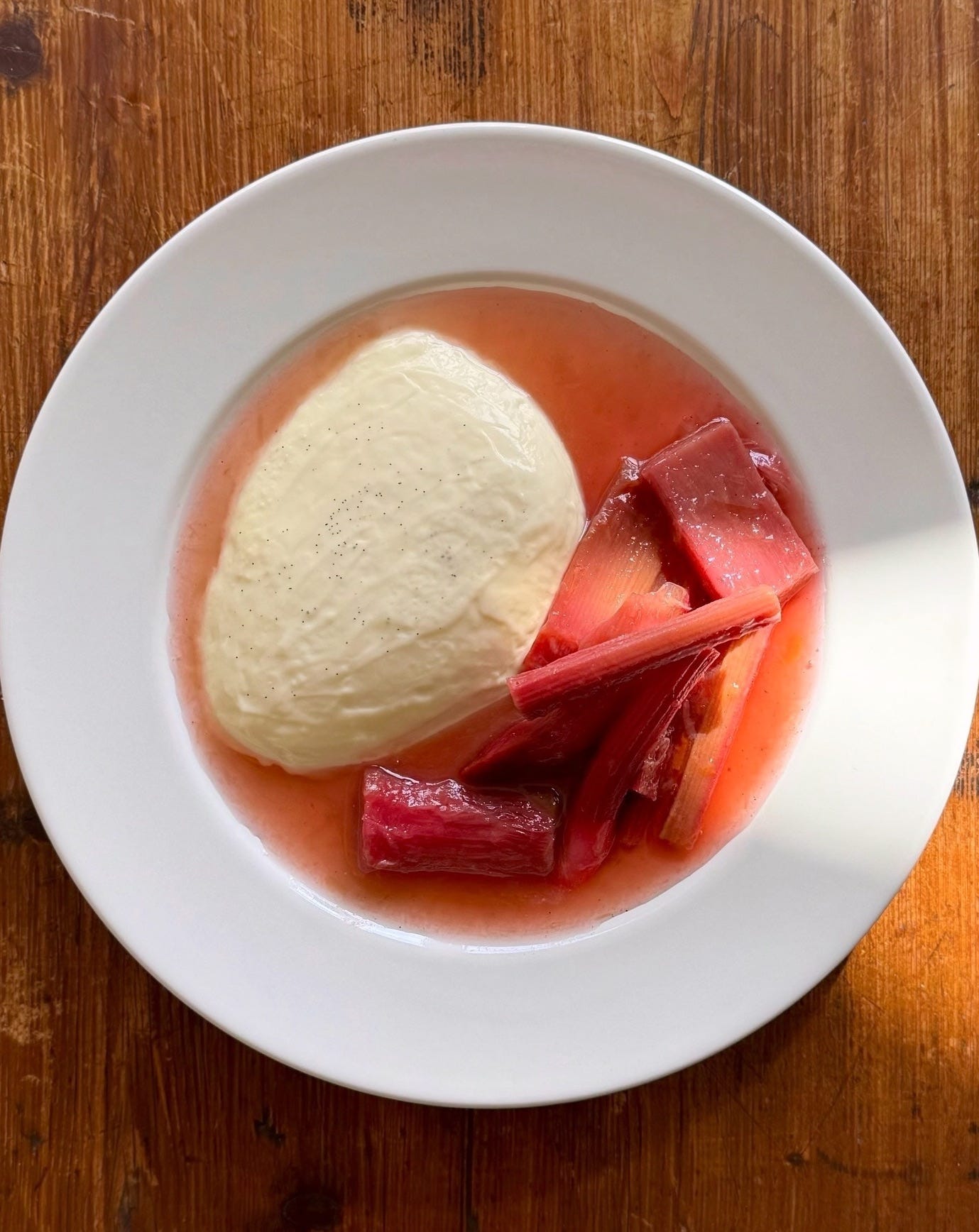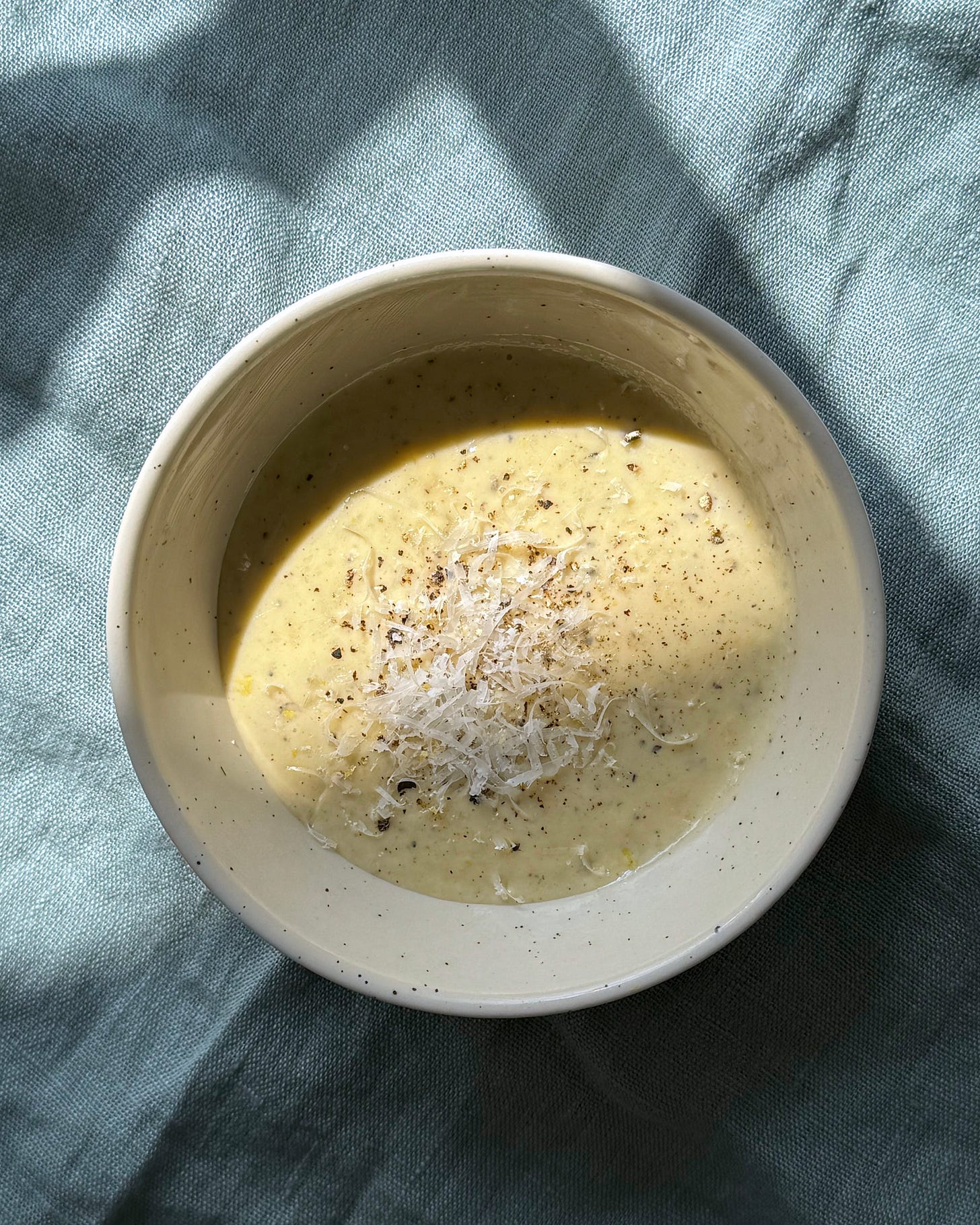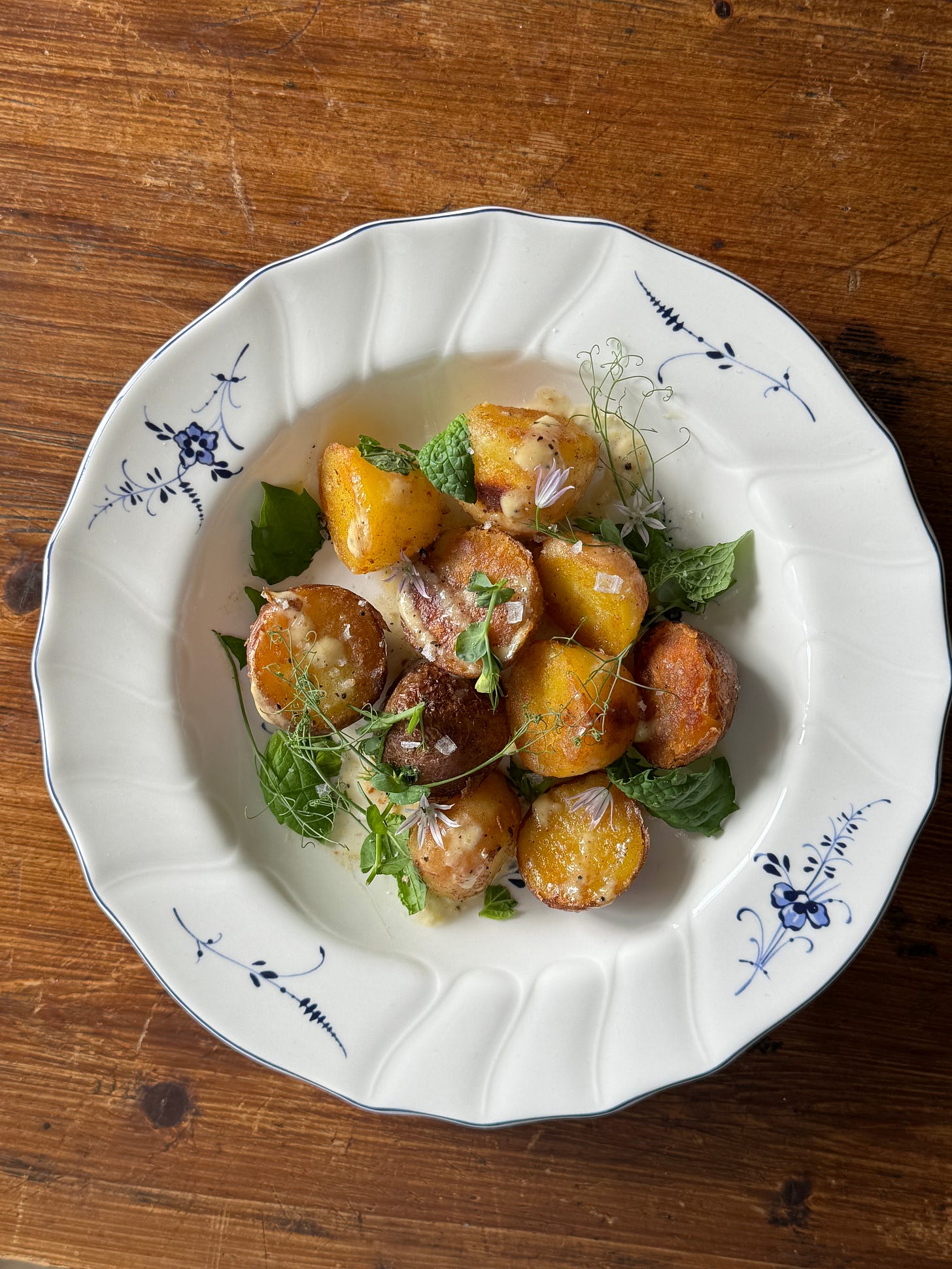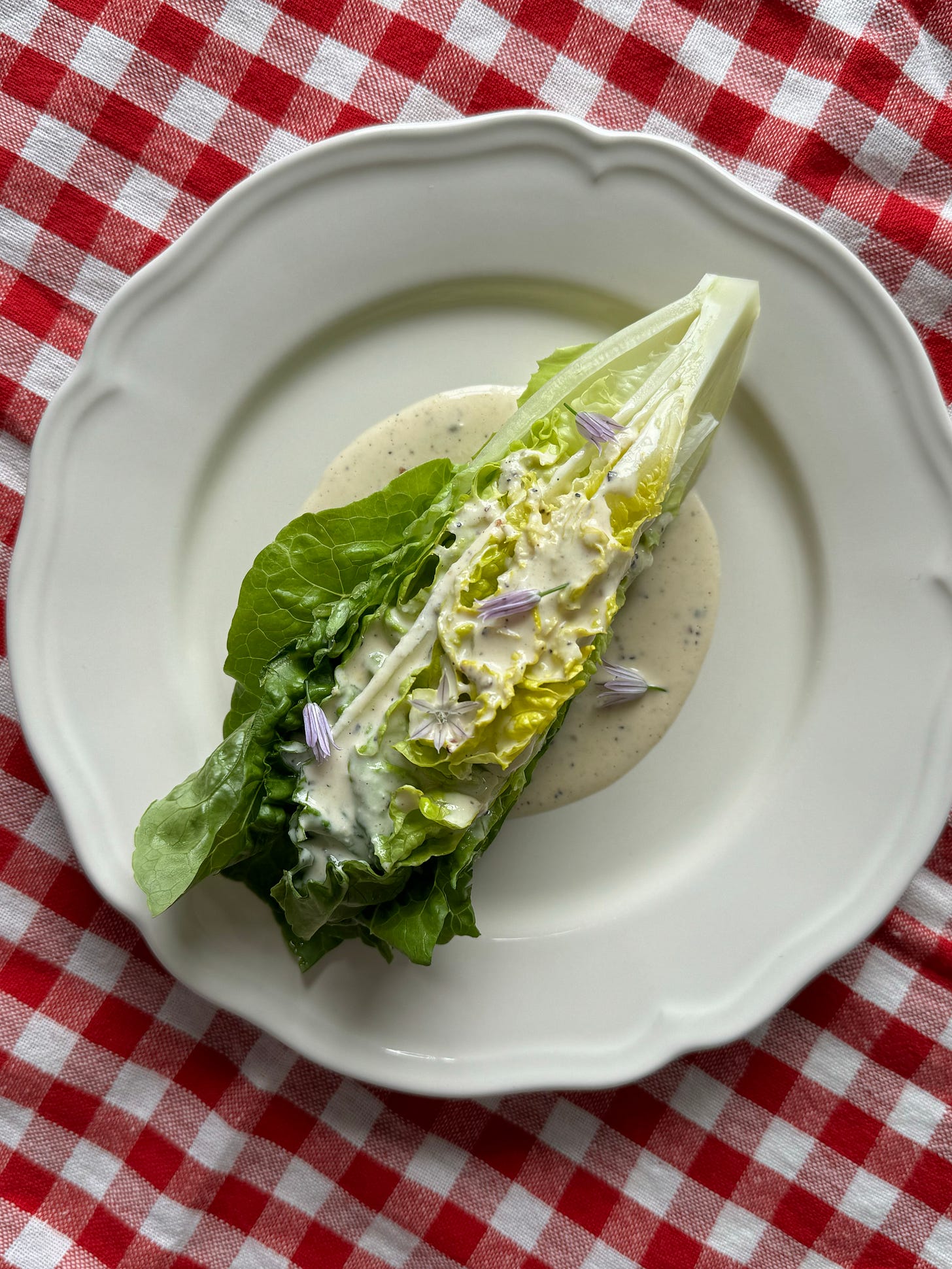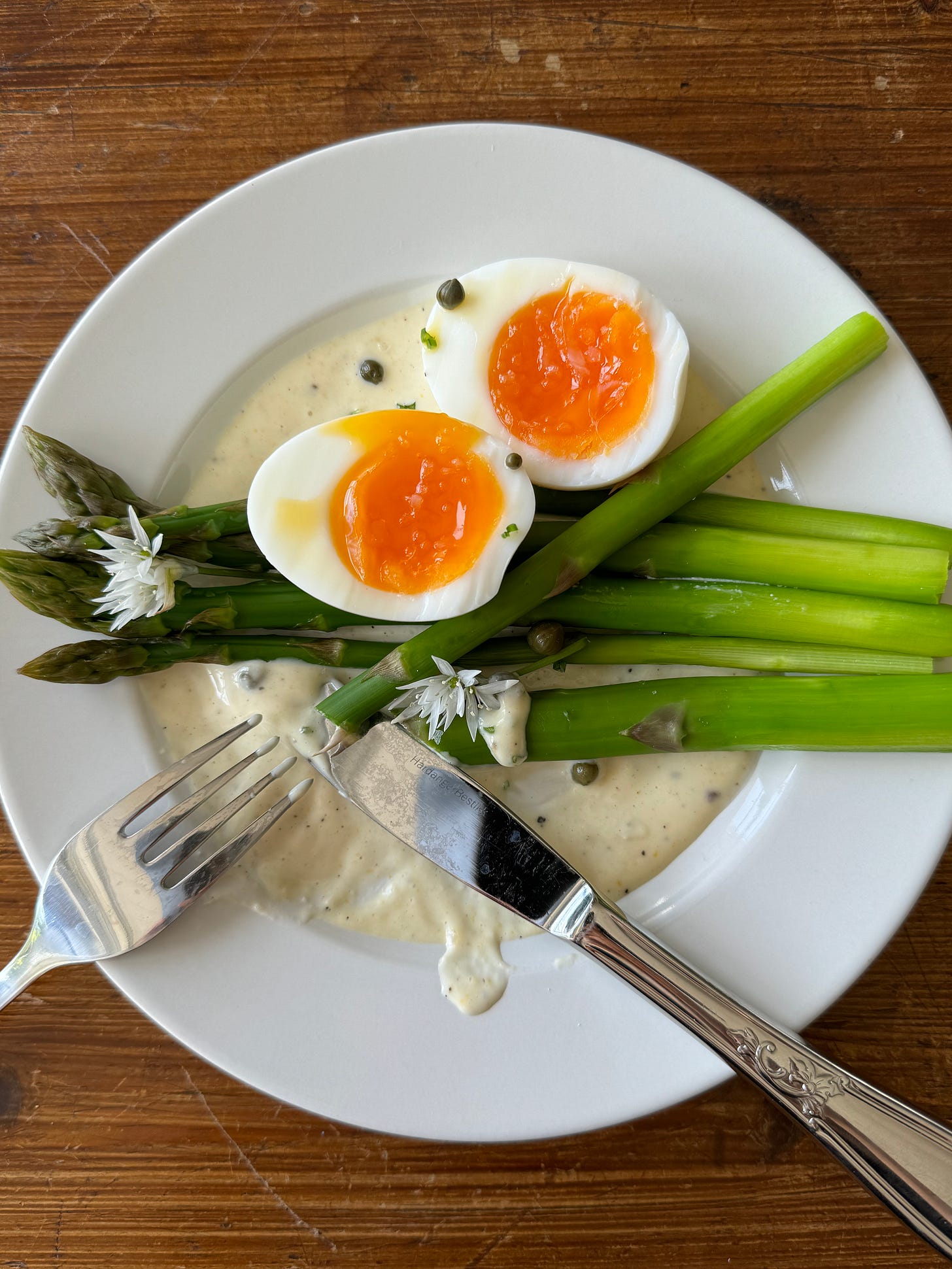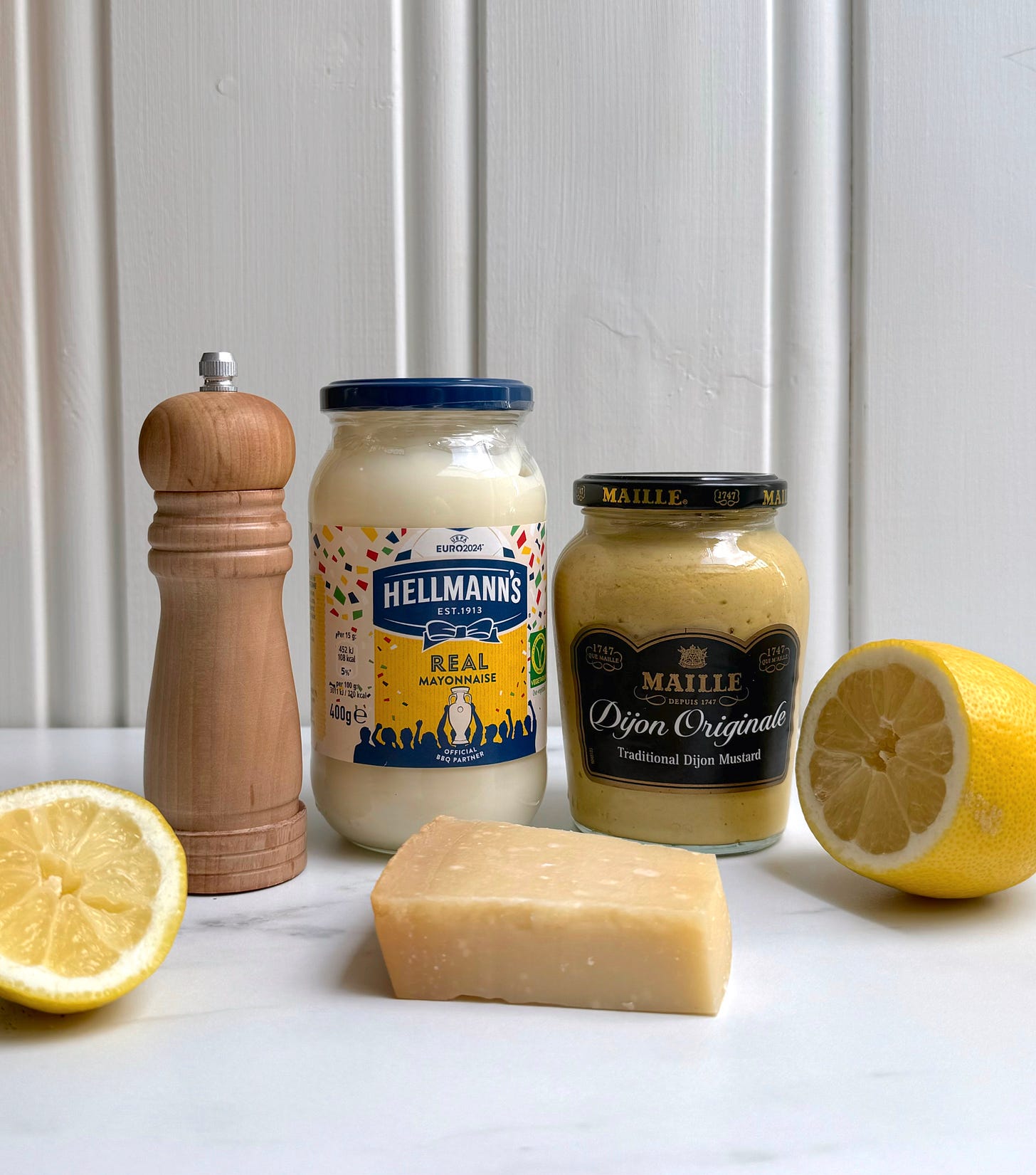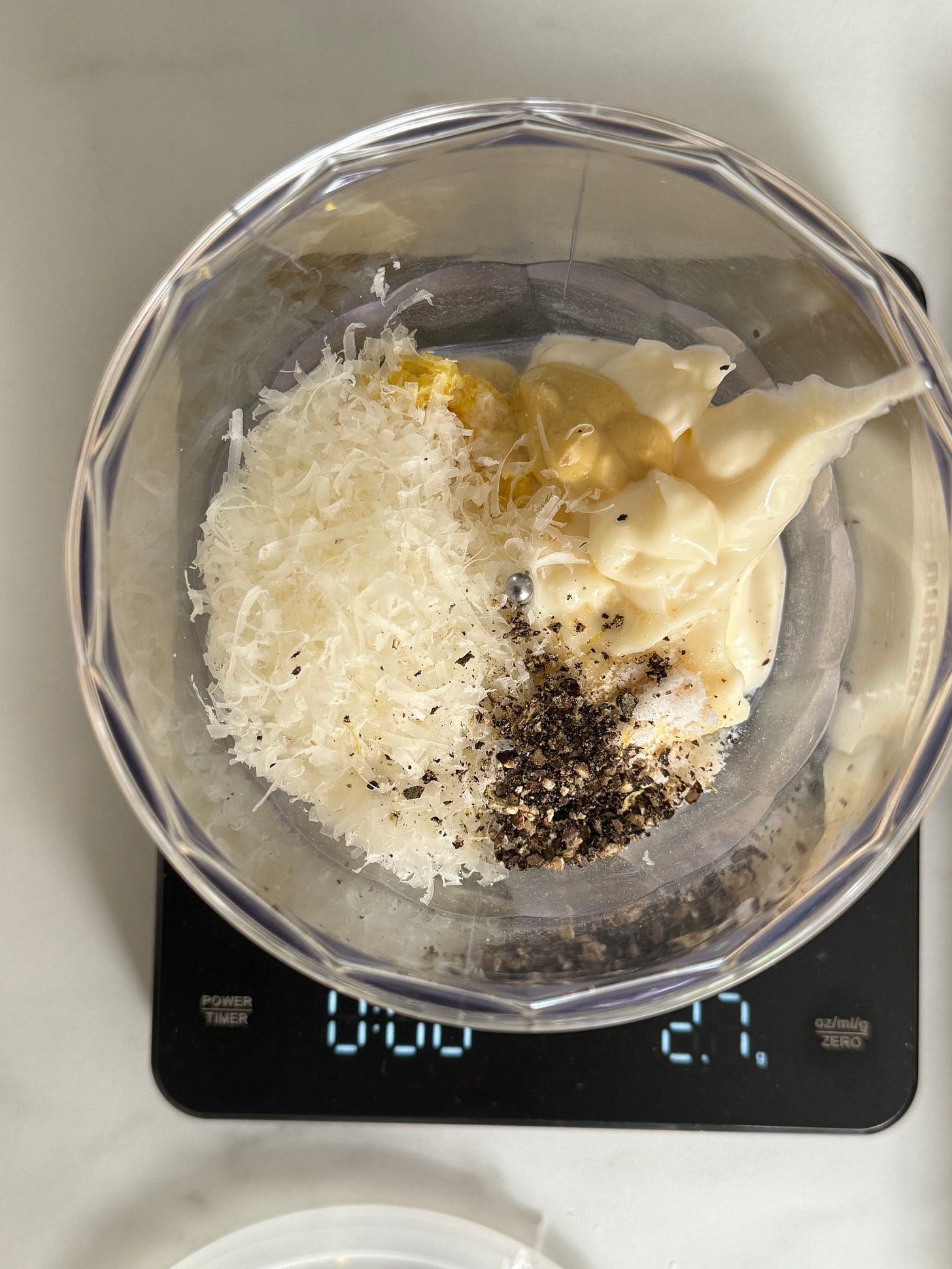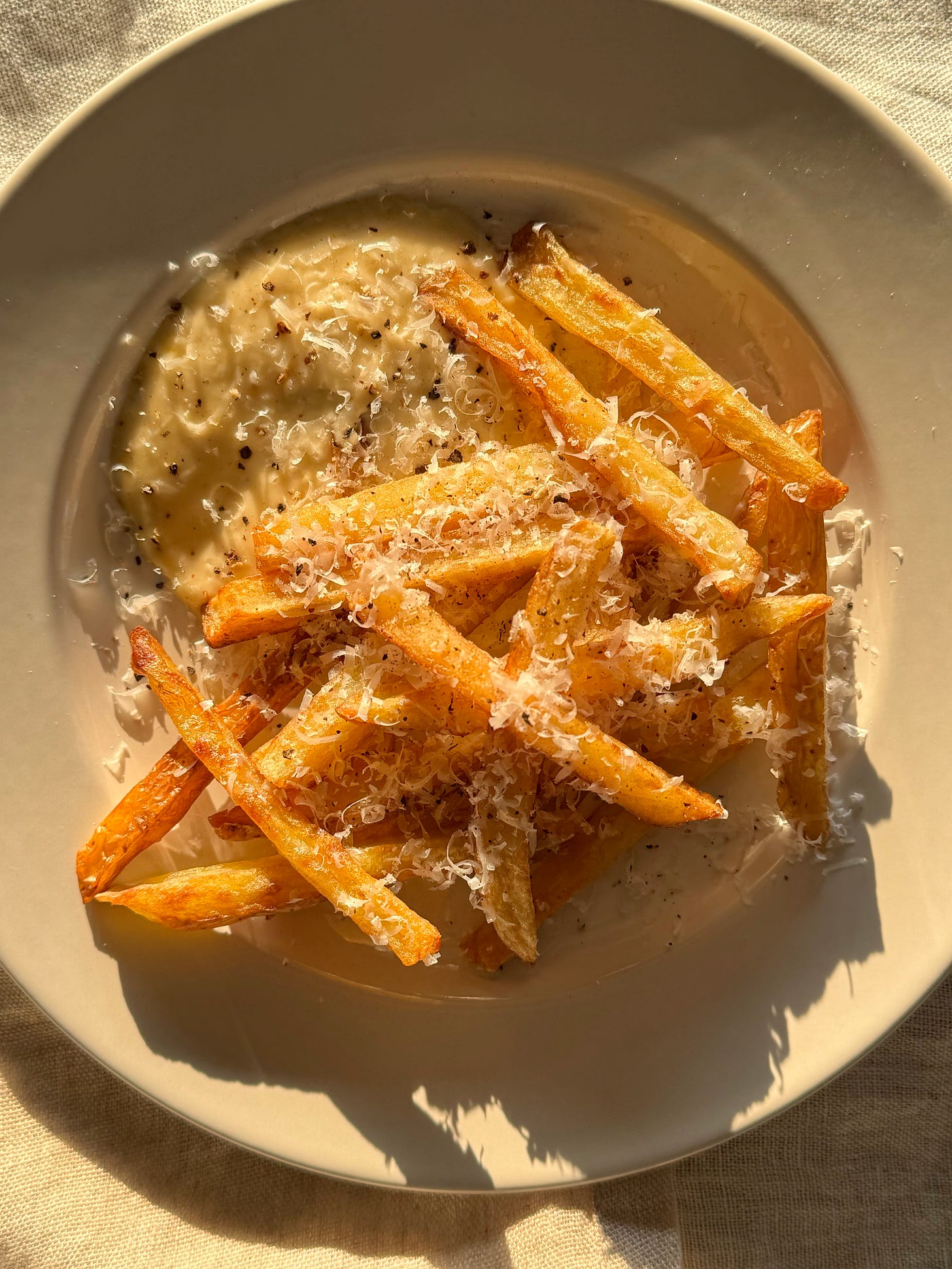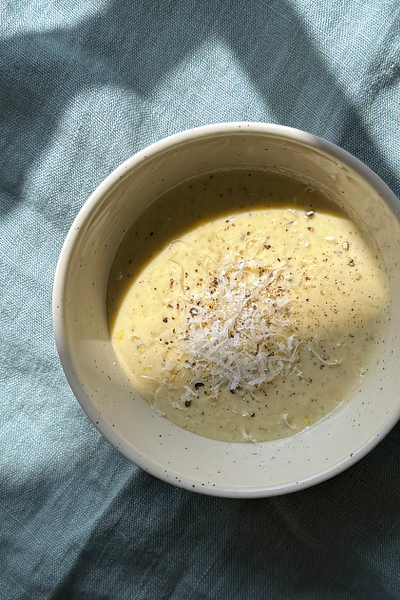Allô! 👋
Welcome (back) to good food at home, a monthly-ish newsletter featuring simple, seasonal, and sustainable meals, tips, and ideas. Thank you for reading! If you’re a new subscriber, you can click here to find all previous issues. For more recipes, cooking Q&As + access to the full archive, consider joining the community of paid subscribers who also receive seasonal sundays, the weekly supplement that celebrates cooking with peak-season produce. Annual subscriptions are currently discounted for a limited time!
Young lettuce, new potatoes, early mint, flowering chives. Birds chirping the whole day through. Rain. Delicate blossoms. Green everywhere you look. At last, late spring is here. Another marker of the season for me: days so long they do not end.
Spring is when Norwegian skies begin to stay light from dusk ‘til dawn. In fact, with each passing day, the slumbering hours that once characterised night’s trademark darkness grow so bright that it becomes impossible to spot celestial bodies* (read: we haven’t seen the stars in weeks, and we won’t see them again for another couple of months).
It’s a confusing time for the regimented sleeper. As in the depths of winter, the rising sun is simply not to be trusted as a sign of a good time to wake.

Another herald of mid- and late- spring, for me, is the clocklike urge to thumb through cookbooks for recipes featuring refreshingly green ingredients, only to promptly ignore them. Okay, well, not ignore them fully, but certainly setting them aside and leaving them be once the time comes to get going in the kitchen.
Following recipes to the letter might be handy when one is completely unfamiliar with a certain dish or technique, but most recipe writers will be the first to tell you that their instructions are mostly meant as experienced and well-tested guidance, if not a source of researched inspiration — not incontrovertible command.
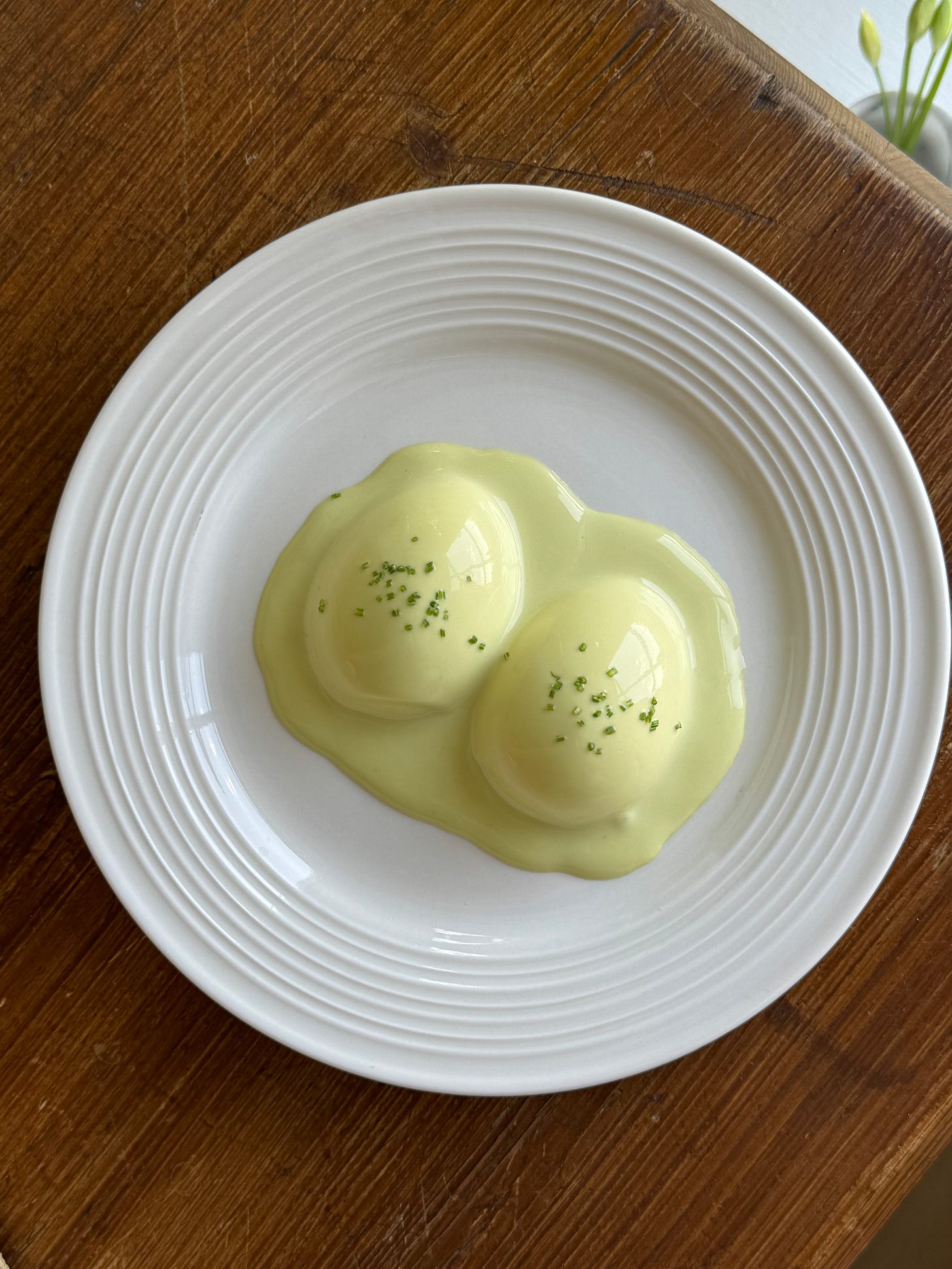
Recipes cannot replace your capacity to notice and observe the evolving processes that occur during cooking, your familiarity with your kitchen’s idiosyncrasies, an intimate knowledge of the ingredients habitually available to you, or the experiences, memories, and lessons you’ve accumulated from cooking and tasting and eating all throughout your life.
I find this to be especially true in spring and summer, when new-season (or, dare I say, new-year) ingredients take turns coming to market.
They are so delicate, so young, so fresh, and taste so much of themselves that — at least at first — you don’t really want or need any recipe to tell you how to prepare or enjoy them†. Most spring things will be delicious raw, as is (or, gasp, boiled briefly just until tender).
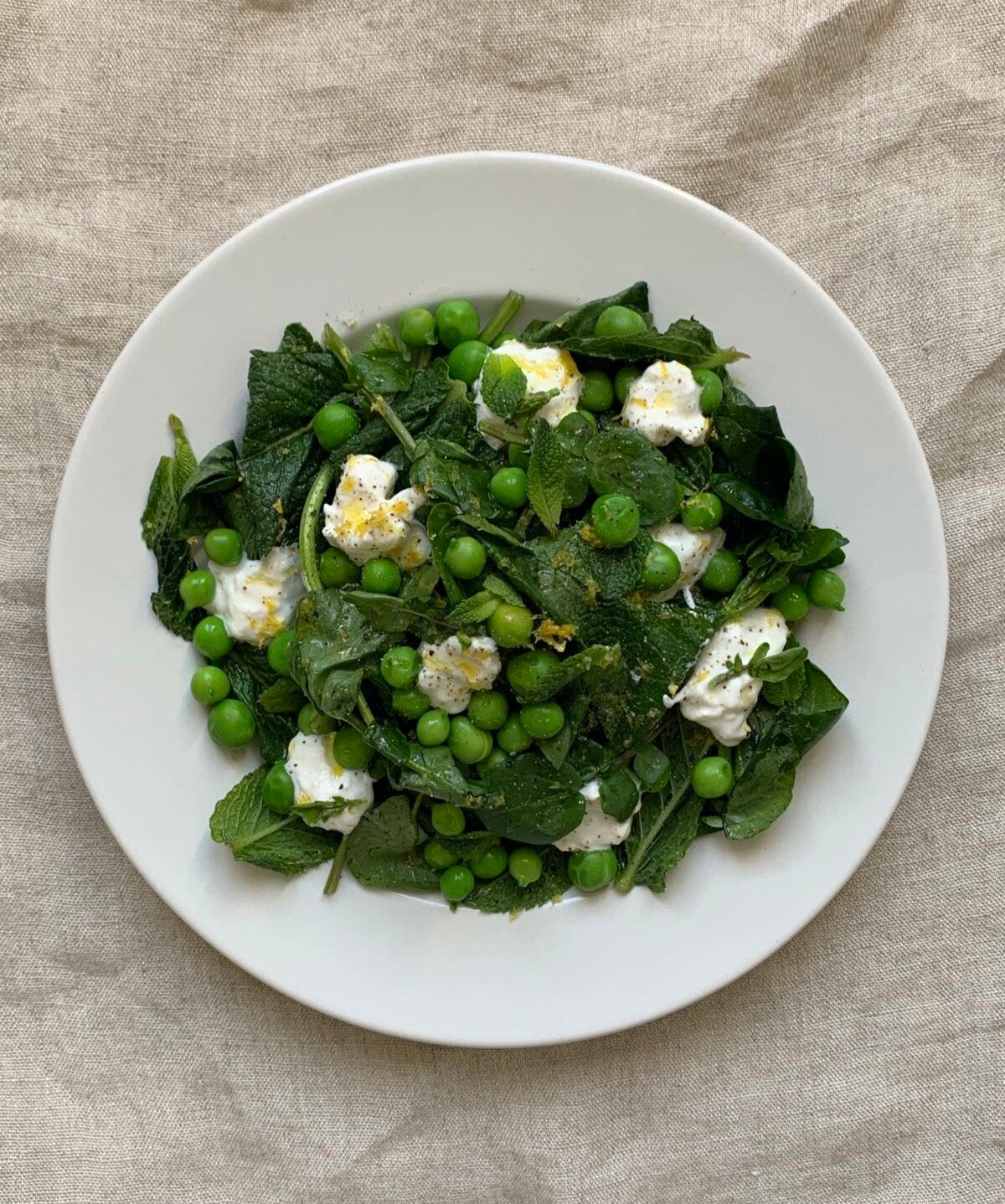
That said, by now you’ve likely already had your first asparagus of the year, your first artichokes, your first radishes. So this newsletter comes with a suggestion for a condiment that you might like to use as a means to zhuzh up any of the aforementioned vegetables, and more, in any way you like.
Consider it an invitation to get playful and ignore the recipe that comes with it.
Let yourself be inspired by the ingredients at hand, by your mood, by the weather and your tastes, or by the preferences of those lucky enough to enjoy any food you care to prepare and share.
In addition to a delightful condiment recipe that I hope you will absorb then ignore, you'll also find in this May issue some recent and popular late spring inspiration from the newsletter and the site, as well as some links to feed your thoughts and conversations in the coming days, weeks, and months.
Until the next newsletter!
Wishing you a happy, safe and healthy month of June,
👋simone
P.S.: I’ve signed this petition — if you haven’t yet, you may want to too
*we’ve now lost astronomical twilight, the period of dusk that occurs just prior to night and which represents the minimal amount of darkness required for the viewing of astronomical objects
†recipes for desserts and baked goods generally benefit from being followed more closely but, even then, one is never fully tied to them
springtime recipes 🌿
Recipes I’d love for you to read through, find inspiration from — and then promptly ignore. Below, some of the latest and most seasonally-suited meals from the newsletter and website (the first features contain sections available only to paid subscribers, but the rest are fully accessible to any and all):
what to do with radishes 💖
Discover radishes in all their springtime glory! This post delves into radish varieties, uses, and how to store them. In addition, paid subscribers get 5 ways to prepare them, plus my best tips on reducing food waste.
three green pastas 🌿
If you’re tired of eating greens in salads, why not try them in, on, and tangled through pasta? Learn more about spring greens in this post — paid subscribers also get three recipes and a peek into what and who’s is inspiring my cooking this spring.
spring blossom recipes 🌸
Some flowers are edible, some flowers are not! Find out all about how to use spring blossoms into the kitchen. Paid subscribers get six methods for prolonging the fun, plus access to a more personal cooking Q&A.
cardamom panna cotta & vanilla poached rhubarb 🥄
Did you know that the “-barb” in rhubarb comes from “barbarian”? Neither did I. Paid subscribers get a recipe for making panna cotta the old-fashioned way (without gelatine), plus a method for gently-poached and subtly-spiced rhubarb.
...and more (open to all):
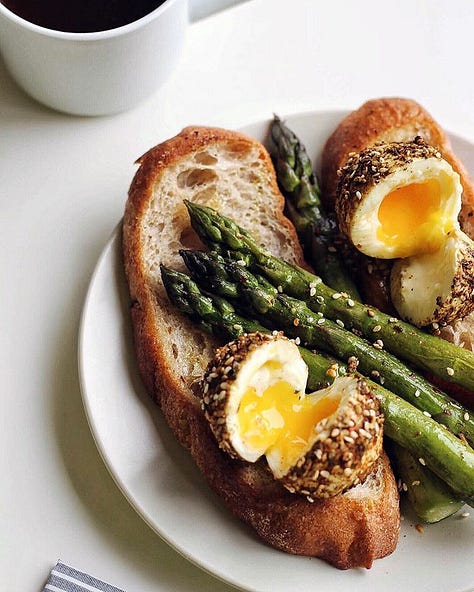
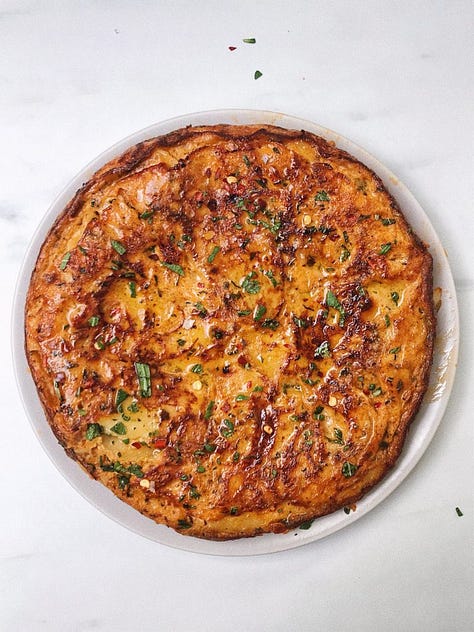
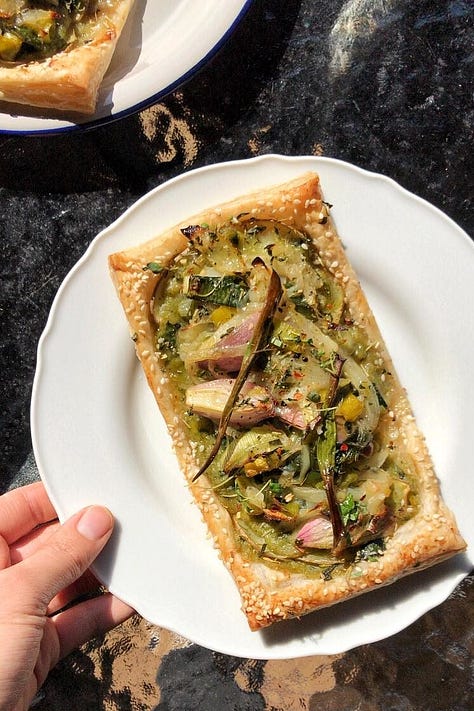
asparagus & spiced eggs on toast
green onion aglio e olio
a spicy and herby spanish omelette
cool pea soup
a light & flaky spring tart
a creamy parmesan dip / sauce / dressing ✨
The gist of this creamy parmesan condiment is sort of a toned-down, cheat’s caesar dressing. It has no anchovies in it, doesn’t require you to whisk up an egg yolk or make your own mayonnaise, and skips the need to finely mince fresh garlic into a paste. Instead, it’s lighter, more lemony, and more peppery — all for less effort and a peppier Parmesan punch.
If you’d like to add Worcestershire sauce to it, or make any adjustment that strikes your fancy, really, be my guest. The whole point is to whip something up that you’d be happy to pour onto, toss through, dip into, and drizzle over (nearly) anything.
So far I’ve enjoyed this condiment — lusciously thick or lovingly loosened — with lettuce, potatoes, asparagus, and soft-boiled eggs, though I reckon it would also go along swimmingly with raw radishes, roasted artichokes, grilled garlic scapes or charred spring onions, and fresh or blanched sugar snaps too.
•••
In the spirit of “ignorable” recipes, I’ve given you measurements that are both colloquial and more precise‡, as an invitation to trust your intuition in terms of which ratios and quantities feel best for you. Then, as always, taste and adjust until you are pleased with the result (a good way to do this, especially if you don’t yet trust your cook’s intuition, is to take a small amount out of what you’re preparing, place it in a separate bowl, then adjust the ingredients in that small sample to see how the flavour, texture, etc. is transformed by your hesitant modifications — this way, if you regret a tweak, you won’t have spoiled the main batch).
‡I pulled out the measuring spoons (1 tsp = 5ml, 1 Tbsp = 15ml) and precision scale to test and re-test the quantities listed below, but such painstaking exactitude is not only excessive, it’s tedious and unnecessary; use the provided numbers as a reference point, then adapt the amounts to your own preference as you go
a saucy parmesan condiment
makes around 75ml or 90g — serves 2-4, depending on use and amount used (doubles and triples well)
INGREDIENTS
• mayonnaise, a good dollop
(1 heaped Tbsp or 35g)
• Dijon mustard, a dash
(1 tsp or so)
• extra virgin olive oil, a small glug
(2 tsp or so)
• lemon zest, a flavoursome amount
(1 heaped tsp)*
• lemon juice, a squeeze or two
(around 1 Tbsp)*
• microplaned Parmesan ideally aged 24 months, a generous amount
(around 3 heaped Tbsps or 17g)
• garlic powder, a few good shakes or pinches
(around 1/2 tsp)
• onion powder, a good shake or pinch
(around 1/4 tsp)
• sea salt, a good pinch
• black pepper freshly cracked, a heavy-handed amount
• optional: a tiny (½ tsp) to a large (1 Tbsp) splash of cold water, to loosen
*: you’ll need around one third of a large, unwaxed, organic lemon for this — or around half of a small one — I like to use most or all of the zest and around half of the juice, but this depends on the lemon and what I’m looking to pair the dressing with; play around with quantities to suit your tastes
note: as mentioned, you’ll want to taste and adjust the balance of ingredients, so it’s a good idea to make sure that you have a little bit extra of each ingredient on hand 💛
METHOD
1. To the cup of a small food processor or immersion blender, add: a good dollop of mayonnaise (one heaped tablespoon), a dash of Dijon mustard (one teaspoon), a small glug of olive oil (one teaspoon or two), all of the zest and around half the juice from one third of a large lemon or from half of a small one (one heaped teaspoon of lemon zest and one scant tablespoon of lemon juice), a generous grating or microplaning of 24-month old Parmesan (around 3 heaped tablespoons, or 17g), a few good shakes or a good pinch or two of dehydrated garlic powder (~half a teaspoon, or 3ml), a little less than that amount of dehydrated onion powder (~half a teaspoon, or 2ml), a good pinch of sea salt — bearing in mind that the Parmesan is salty too — and lots of freshly cracked black pepper. To finish, add in a tiny splash of water (start with a little less than a teaspoon, or 3ml) to help the mixture come along in the blender.
Err on the conservative side if you are unsure about which ratios or quantities will suit you most: remember that you can always add more, but you cannot remove anything you’ve already put in.
2. Blitz everything together until it’s as homogenous as can be. Dip a finger in to taste or, if you already have the ingredient you wish to serve with the dip / sauce / dressing on hand, use it to taste the condiment in context. Add in more ingredients if necessary to adjust the flavour and texture so as to please you most — once done, it should taste almost (but not quite) overly seasoned.
3. You may use the dip / sauce / dressing immediately, but the flavours do improve and deepen if left to mingle and marinate for at least an hour in the fridge. For a looser texture, add a tiny bit of water at a time to dilute (after which, you may have to rectify the seasoning). Serve with more microplaned Parmesan, flaky sea salt and freshly cracked pepper on top if desired.
Keeps well in the fridge in an airtight container for up to 4 days.
last, but not least:
the public health corner 🔗
In case you didn’t know, public health is my jam (more on that here, here, and here) — it informs everything I do! And, as always, I like to leave you with a few parting links relating to the topic, as food for thought:
📺 ONE VIDEO
Marcus Wareing Simply Provence: Episode 1 (BBC)
🗒️ ONE ARTICLE
‘Deny, denounce, delay’: the battle over the risk of ultra-processed foods (Financial Times)
🎧 ONE PODCAST EPISODE
Lessons from Leeds and Amsterdam on childhood obesity, The Food Programme
📘 ONE BOOK
We Are What We Eat: A Slow Food Manifesto, by Alice Waters (Penguin Books)
p.s. I usually have a hard time just picking one of each so, in case you're interested, there's plenty more where that came from
That's all from me this month! See you again next season 💛


